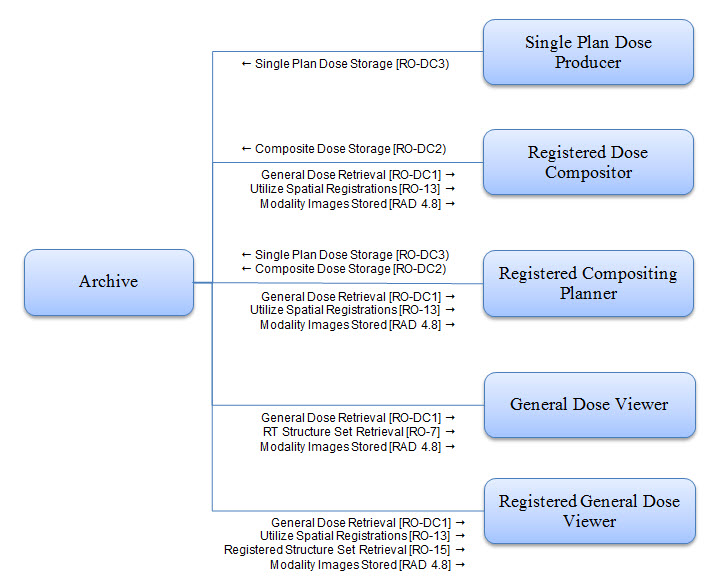Dose Compositing
Dose Compositing (DCOM) dose summation for composite doses and previous dose treatment planning
Summary
This profile defines the relevant standards and constraints on those standards needed to implement interoperable transfer of spatially-related dose information between systems for the purpose of combining or compositing radiation doses. In this context, the term Dose Compositing is used to denote the process of combining information from two or more spatially-related 3-D dose matrices for a patient, where the dose matrices are encoded as DICOM RT Dose instances. The spatial relationship between doses is defined by the rigid transformation encoded in a DICOM Spatial Registration object. (Affine and deformable registrations are not supported by this profile.) The process of combining two or more 3-D dose matrices may involve resampling of the dose array or scaling of dose values as needed to account for differing fractionation and radiation type.
Benefits
- Defines the characteristics in a plan-modality-independent manner allowing composite doses for mixed modality treatments to be calculated
- Allows inclusion of previous dose to be used to design a new treatment plan. This gives the clinician the ability to design a plan that includes variations in previous dose deliveries in a subsequent plan.
Details
This supplement defines the relevant standards and constraints on those standards needed to implement interoperable transfer of spatially-related dose information between systems for the purpose of combining or compositing radiation doses. In this context, the term Dose Compositing is used to denote the process of combining information from two or more spatially-related 3-D dose matrices for a patient, where the dose matrices are encoded as DICOM RT Dose instances. The spatial relationship between doses is defined by the rigid transformation encoded in a DICOM Spatial Registration object. (Affine and deformable registrations are not supported by this profile.) The process of combining two 3-D dose matrices may involve resampling, scaling, or transformations needed to account for differing fractionation and radiation type.
Two distinct Use Cases are supported by this profile. Both involve accepting dose matrices, each defined in its own frame of reference, as well as Spatial Registration object(s) relating those frames of reference to a “destination” frame of reference. In the first Use Case, the Registered Dose Compositor Actor combines two or more, spatially-related dose instances to produce an output dose instance in the destination frame of reference. In the second Use Case, the Registered Compositing Planner Actor uses one or more dose instances as the basis (“prior dose”) for creating a new treatment plan and dose instances. Dose objects accepted by the Registered Dose Compositor and Registered Compositing Planner Actors are those stored by the Single Plan Dose Producer, Registered Dose Compositor, or Registered Compositing Planner actors.
In addition, the profile defines two dose viewer actors to permit display of single plan or composite doses without requiring an accompanying plan instance. The General Dose Viewer Actor retrieves and displays Modality Image(s), RT Structure Set, and a General Dose. It requires that dose, images, and structure set share the same frame of reference. The Registered General Dose Viewer Actor retrieves Modality Image(s), Registered RT Structure Set, General Dose, and Spatial Registration. It displays doses registered to the image/structure set frame of reference.
Systems Affected
- Radiation Oncology PACS
- Treatment Planning Systems
Actors and Transactions:
Specification
Profile Status: Draft for Final Text
Testing Status: Current - May be tested at an IHE-RO Connectathon
Documents: IHE Radiation Oncology Technical Framework:
- DCOM Supplement - Chapter 9
Underlying Standards:
See Also
Related Profiles
- Basic Radiation Therapy Objects (BRTO) Provides base requirements for Single Plan Dose Producers
- Multimodality Registration for Radiation Oncology (MMRO) Provides base requirements for Spatial Registration Objects and RT Structure Sets
Consumer Information
- The DCOM FAQ answers typical questions about what the Profile does.
- The DCOM Purchasing describes considerations when purchasing equipment to deploy this Profile.
Implementer Information
- The DCOM Implementation provides additional information about implementing this Profile in software.
This page is based on the Profile Template
